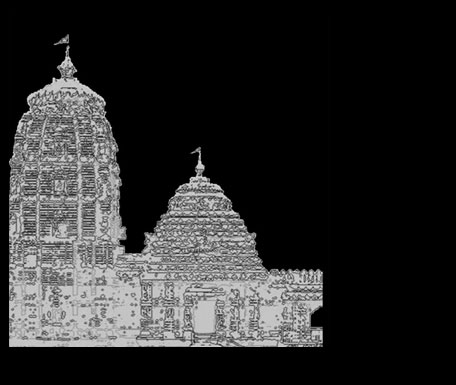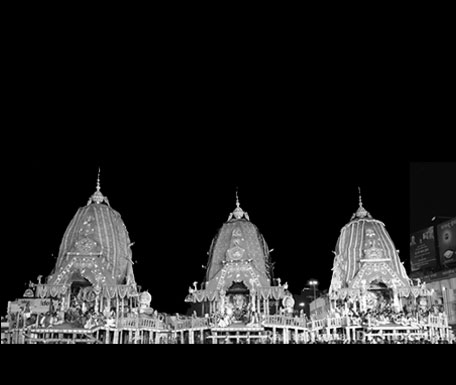





COMPOUND WALL (The Meghanada pacheri): The Main temple and other shrines of Lord Ganesh, Kasivishwanah, Maa Laxmi, Bimala, Anjaneya swamy and Navagrahas are surrounded by wall adorned with mythological and religious Murals. The Murals are excellent pieces of art and are educative. The murals on the exterior wall near eastern gate- the singha dwara depict the story of construction of Jagannath temple in additions to several other depictions. The Dasavatar is one of the best attractions on the inside of the outer wall.
SIMHA DWARA: (Lions Gate or eastern gate) - It is one of the four entrances to the temple and considered the main entry. It is named so as on either side there are two colossal statues of couching lion with crowns on their head. The gate faces east and therefore is also known as Purva Dwara or the eastern gate. The gate is intricately designed and carved and is of artistic finery and beauty. During Ratha Jatra the idols of Lord Jagannath, Balabhadra and Maa Subhadra is taken out to the chariot through this gate. The statue of Lord Mahalaxmi is at the top of the door. The door symbolizes the principle of Dharma and also the majesty of strength through the lion.
VYAGHRA DWARA: The Western door (Tiger gate) is guarded by two statues of Tiger is also known as Paschima dwara or Vyaghra dwara. It symbolizes Mokshya and Vairagya (Renunciation) and energy by different schools of believers.
HATHI DWARA: The northern door, the hathi dwara or Uttara Dwara is also symbolically indicated in this temple in view of constraint of access to temple from Northern side. This gate represents artha or prosperity different believers.
ASWA DWARA: The southern gate is guarded by two statues of horses. This Aswa dwara symbolically represent Kama or Gyana (Knowledge) or military powers.
Navagraha statues are placed on the all the gates in addition to small images of Shiva, Vishnu, Hanuman, Durga and Narasimha.
ARUNA STAMBHA: The pillar is named after Aruna the charioteer of the Sun God. In Puri it is a sixteen sided pillar (Height 25' 2'') circumference 6' 3.5". Aruna in prayer mode. An elegant and master piece of art.
It is placed before the temple as the Sun God is considered identical with Vishnu from Vedic times.
An Aruna stamba cladded with carved and designed brass plates adorn the Jagannath Temple at Hyderabad. Artistic and imposing it stands tall at 20 feet.
BAISI PAHACHA (Twenty two steps):
After entering the temple premises from the eastern gate one needs to climb 22 steps to proceed towards sanctum sanctorum of Lord Jagannath. In Puri temple each of these steps are 70ft in length 6ft in width and 6 to 7 inches in height. Here the steps are symbolic and does not confirm to this measurement. The steps are given a lot of divine significance and considered auspicious for numeracy holy activities. It is believed that during the car festival several Gods, Goddesses, demigods heavenly entities, souls of ancestors, Chitragupta and Yamadootas descend upon these steps to witness the Pahandi of Lord Jagannath during the Ratha Jatra/ Car festival.
Madan Mohan the representative idol of Lord Jagannath offers pindadana on these steps to His ancestors-Nanda and Yashoda, Devaki and Vasudeva, Koushalya and Dasaratha on chaturdashi theethi of the dark fortnight in the month of Margasira. He also offers pindadana to King Indradyumna who built the temple and queen Gundicha since they were childless. The steps are also called steps of self control as these steps represent 22 kinds of faults and weaknesses in human being.
Put a speck of dust from the surface of these steps on your forehead you get a sense of fulfillment and all your sins will disappear.
Children are made to roll down on the steps to bring them spiritual bliss and happiness.
Each of these sacred steps is named differently as:
1) Tidva 2)Kumundati 3) Manda 4) Chalobati 5)Dayabati 6) Rajani 7) Ratika 8) Raohi 9)Krodha 10)Bajrika 11)Prasavani 12) Priti 13)Marjana 14)Khati 15)Rakta 16)Sandhipani 17)Alapani 18)Mandanti 19)Rohini 20) Gamya 21)Ugra 22)Khorini
Crossing of 22 steps means crossing the 22 short comings to see the Lord. The short comings (Para Prakriti) are Kama, Sambhoga, Keli, Lova, Sancaya, Kosa or Panjikarana, Abhamaya, Himsa, Ersa, Kisunata, Kapata, Mithya, Hhuna, Ninda, Ajanta, Krodha , Raga, Dvesa, Ahankar, Mada or Parba, Uthkantha, Maithuna.
It is also believed that Baikuntha the abode of Lord Vishnu is situated above saptaloka, sapta patala and asta baikuntha (22 stages) one has to cross them to reach the Lord. Thus the steps in the temple to take the devotees to sanctum to have his Darshan.
Hyderabad temple also has 22 steps leading to Garuda stamba and to sanctum there after though not of same specification as that of Puri Temple.
GARUDA STAMBHA: Cosmic column which joins heaven and earth. Garuda is a vehicle of Lord Vishnu. Garuda is ever ready to serve the Lord with exemplary devotion and extraordinary power. Garuda is constantly watching the Lord on the Ratnavedi. Garuda Deva is installed on the column made out of wood and cladded with intricately woven brass at the entrance of Nata Mandir. The devotees before proceeding towards the sanctum touch and go into extraordinary devotion and a state of surrender to the Lord. A mere touch is assuring and arouses a cosmic connect with the devotee. Garuda Stambha is of same importance as Nandi in Shiva temple.
NILA CHAKRA: The Neela chakra or the Blue Wheel adorns the top of the temple. The wheel symbolizes the Sudarshan Chakra, the most powerful disc weapon of Lord Vishnu. The wheel is made out of alloys of eight metals consisting of iron, copper, Zinc, mercury, lead, brass, silver and gold.
The Neela chakra in Puri temple weighs 2200 Kgs and has a height of 11 ft 8 inches with a diameter of 7ft 6inches. There are 8 wheel bars in the chakra. The Neela chakra has eight Navagunjaras carved in the outer circumference all facing towards the flag post above. The Neela chakra in this temple is much similar but small in size and about 2'X3' in width and height and weighs about 100 Kgs.
Flag is flown tied to the mast attached to Nilachakra. It is a pious and holy act to offer the flags to the temple. The flags usually are in deep red or yellow in colour with crescent Moon and a Sun in white colour cloth in centre of flag. The flag changing ceremony is a breath taking exercise and a great attraction for the devotees.